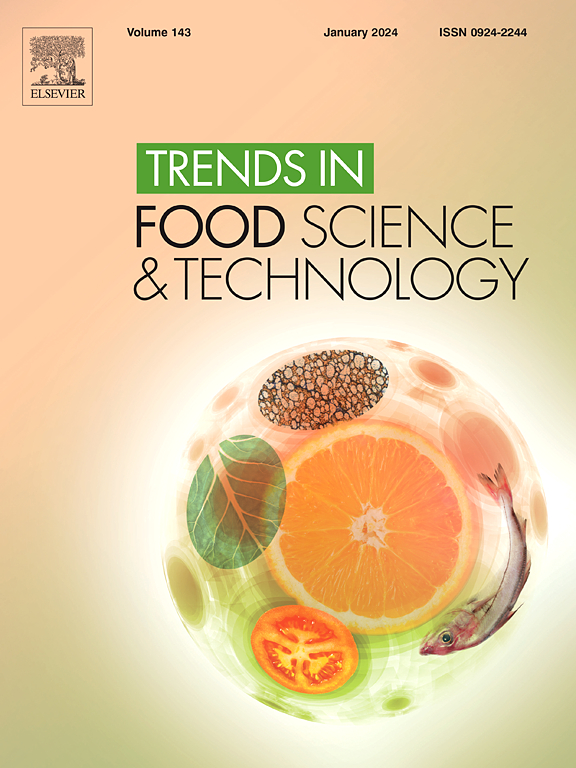Artificial intelligence in smart seafood safety across the supply chains: Recent advances and future prospects
IF 15.4
1区 农林科学
Q1 FOOD SCIENCE & TECHNOLOGY
引用次数: 0
Abstract
Background
Aquatic blue foods are critical to global food security and nutrition, yet the sector faces growing challenges from food safety, supply chain complexity, and sustainability concerns. The integration of artificial intelligence (AI) technologies across the seafood supply chain offers transformative opportunities to enhance detection accuracy, ensure safety, improve efficiency, and promote sustainable development.
Scope and approach
This review systematically summarizes recent advances in AI-enabled intelligent safety monitoring and processing strategies spanning the entire aquatic food chain, from aquaculture production to post-harvest handling and retail. Key developments are highlighted in four major areas: (i) smart aquaculture systems for effective supply and resilience enhancement of seafood; (ii) AI-driven seafood freshness monitoring leveraging smart packaging, sensors, and computer vision technologies; (iii) automated pre-processing of fish products including species classification, morphometric estimation, and intelligent cutting systems; and (iv) AI-guided detection of seafood adulteration, such as species substitution, origin mislabeling, and frozen-thawed fraud. Finally, we discussed current challenges and offered perspectives on advancing AI-driven systems for seafood safety detection and traceability.
Key findings and conclusions
AI is a crucial means to ensure the effective supply of aquatic products and maintain food safety. It has demonstrated superior capabilities in non-destructive sensing, multidimensional data processing, and real-time decision support. Despite significant progress, challenges such as model generalization, dataset standardization, and the development of field-deployable intelligent systems remain pressing. Future research directions include integrating AI with novel sensor platforms, developing robust multimodal data fusion techniques, and advancing predictive models to achieve resilient and sustainable aquatic food supply chains.
智能海鲜安全供应链中的人工智能:最新进展和未来展望
水生蓝色食品对全球粮食安全和营养至关重要,但该行业面临着来自食品安全、供应链复杂性和可持续性问题的日益严峻的挑战。人工智能(AI)技术在整个海产品供应链中的整合为提高检测准确性、确保安全、提高效率和促进可持续发展提供了变革性机会。本综述系统总结了人工智能支持的智能安全监测和处理策略的最新进展,涵盖了从水产养殖生产到收获后处理和零售的整个水产食物链。重点介绍了四个主要领域的关键发展:(i)智能水产养殖系统,以提高海产品的有效供应和抵御能力;(ii)利用智能包装、传感器和计算机视觉技术的人工智能驱动的海鲜新鲜度监测;(iii)鱼类产品的自动前处理,包括物种分类、形态估计和智能切割系统;(iv)人工智能引导的海鲜掺假检测,如物种替代、原产地错误标签和冻融欺诈。最后,我们讨论了当前的挑战,并就推进人工智能驱动的海产品安全检测和可追溯性系统提供了观点。主要发现与结论sai是保证水产品有效供应、维护食品安全的重要手段。它在非破坏性传感、多维数据处理和实时决策支持方面表现出卓越的能力。尽管取得了重大进展,但模型泛化、数据集标准化和现场可部署智能系统的开发等挑战仍然紧迫。未来的研究方向包括将人工智能与新型传感器平台集成,开发强大的多模态数据融合技术,以及推进预测模型,以实现弹性和可持续的水产食品供应链。
本文章由计算机程序翻译,如有差异,请以英文原文为准。
求助全文
约1分钟内获得全文
求助全文
来源期刊

Trends in Food Science & Technology
工程技术-食品科技
CiteScore
32.50
自引率
2.60%
发文量
322
审稿时长
37 days
期刊介绍:
Trends in Food Science & Technology is a prestigious international journal that specializes in peer-reviewed articles covering the latest advancements in technology, food science, and human nutrition. It serves as a bridge between specialized primary journals and general trade magazines, providing readable and scientifically rigorous reviews and commentaries on current research developments and their potential applications in the food industry.
Unlike traditional journals, Trends in Food Science & Technology does not publish original research papers. Instead, it focuses on critical and comprehensive reviews to offer valuable insights for professionals in the field. By bringing together cutting-edge research and industry applications, this journal plays a vital role in disseminating knowledge and facilitating advancements in the food science and technology sector.
 求助内容:
求助内容: 应助结果提醒方式:
应助结果提醒方式:


